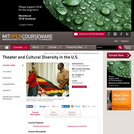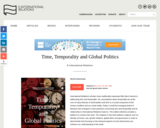
This section discusses the composition of the Texas State Legislature.
- Subject:
- Political Science
- Material Type:
- Reading
- Author:
- Annette Howard
- Date Added:
- 01/08/2020

This section discusses the composition of the Texas State Legislature.

This section discusses the composition of the Texas State Legislature.

This course explores contemporary American theatrical expression as it may be organized around issues of gender and cultural identity. This exploration will include the analysis of performances, scripts, and video documentation, as well as the invention of original documents of theatrical expression. Class lectures and discussions will analyze samples of Native American, Chicano, African American, and Asian American theater, taking into consideration the historical and political context for the creation of these works. Performance exercises will help students identify theatrical forms and techniques used by these theaters, and how these techniques contribute to the overall goals of specific theatrical expressions.

This course explores contemporary American theatrical expression as it may be organized around issues of gender and cultural identity. This exploration will include the analysis of performances, scripts, and video documentation, as well as the invention of original documents of theatrical expression. Class lectures and discussions will analyze samples of Native American, Chicano, African American, and Asian American theater, taking into consideration the historical and political context for the creation of these works. Performance exercises will help students identify theatrical forms and techniques used by these theaters, and how these techniques contribute to the overall goals of specific theatrical expressions.

International Relations scholars have traditionally expressed little direct interest in addressing time and temporality. Yet, assumptions about temporality are at the core of many theories of world politics and time is a crucial component of the human condition and our social reality. Today, a small but emerging strand of literature has emerged to meet questions concerning time and temporality and its relationship to International Relations head on. This edited collection provides a platform to continue this work. The chapters in this book address subjects such as identity, terrorism, war, gender relations, global ethics and governance in order to demonstrate how focusing on the temporal aspects of such phenomena can enhance our understanding of the world.

This course considers reggae, or Jamaican popular music more generally—in its various forms (ska, rocksteady, roots, dancehall)—as constituted by international movements and exchanges and as a product that circulates globally in complex ways. By reading across the reggae literature, as well as considering reggae texts themselves (songs, films, videos, and images), students will scrutinize the different interpretations of reggae’s significance and the implications of different interpretations of the story of Jamaica and its music. Beginning with a consideration of how Jamaica’s popular music industry emerged out of transnational exchanges, the course will proceed to focus on reggae’s circulation outside of Jamaica via diasporic networks and commercial mediascapes. Among other sites, we will consider reggae’s resonance and impact elsewhere in the Anglo Caribbean (e.g., Trinidad, Barbados), the United Kingdom (including British reggae styles but also such progeny as jungle, grime, and dubstep), the United States (both as reggae per se and in hip-hop), Panama and Puerto Rico and other Latin American locales (e.g., Brazil), Japan and Australia, as well as West, South, and East Africa (Côte d’Ivoire, Tanzania, Uganda).

Courses in the Topics in Social Theory and Practice series feature in-depth considerations of such topics with reflections on their implications for social change.
The topic for Fall 2014 is race and racism. We will consider a variety of arguments for and against the biological and / or social “reality” of race—taking into account purported races other than those defined by the black / white binary and the intersection of race with other social categories. We will then consider a number of accounts of racism, contemporary manifestations of racism, and potential counter-measures.

This subject aims to provide an overview of contemporary texts in regional languages in South Asian Literature and Cinema. We will cover major authors and film makers, writing from Bangladesh, India, Nepal, Pakistan and Sri Lanka. Within India, we will look at authors and directors working in different regional languages and as we examine their different socio-cultural, political and historical contexts we will attempt to understand what it means to study them under the all-unifying category of “South Asian Literature and Culture”. Some of the major issues we shall explore include caste, gender, globalization and social change. We will end with exploring some of the newer, younger writers and directors and try to analyze some of the thematic and formal shifts in their work. Authors include Ashapurna Devi, Manto, Vijayan, Premchand, Mohanty, and Nasreen and film makers will include Adoor Gopalakrishnan, Satyajit Ray, Shyam Benegal, Aparna Sen and Rituporno Ghosh.

This course explores the forms, contents, and context of world traditions in dance that played a crucial role in shaping American concert dance. For example, we will identify dances from an African American vernacular tradition that were transferred from the social space to the concert stage. We will explore the artistic lives of such American dance artists as Katherine Dunham, Pearl Primus, and Alvin Ailey along with Isadora Duncan, Martha Graham, George Balanchine, and Merce Cunningham as American dance innovators. Of particular importance to our investigation will be the construction of gender and autobiography that lie at the heart of concert dance practice, and the ways in which these qualities have been choreographed by American artists.

This is a collection of the best and most enduring articles published in Trouble and Strife: The Radical Feminist Magazine, during its 20-year life, including pieces by Stevi Jackson, Diana Leonard, Julia Swindells, Sara Scott and Liz Kelly.

U.S. History is designed to meet the scope and sequence requirements of most introductory courses. The text provides a balanced approach to U.S. history, considering the people, events, and ideas that have shaped the United States from both the top down (politics, economics, diplomacy) and bottom up (eyewitness accounts, lived experience). U.S. History covers key forces that form the American experience, with particular attention to issues of race, class, and gender.

This subject examines the unique culture that developed in the United States after World War II. The dawn of the nuclear age and the ensuing Cold War fundamentally altered American politics and social life. It also led to a flowering of technological experimentation and rapid innovation in the sciences. Over the course of the term, students will explore how Americans responded to these changes, and how those responses continue to shape life in the US today.

Economic, religious, gender, and ethnic differences must be negotiated every day in the urban arena. When tensions and conflict escalate into violence, the urban space becomes the battlespace in which these tensions are negotiated. This course examines urban development challenges in conflict cities through multiple disciplinary perspectives on urban conflict. This course also reviews literature that focuses on when violence and cities intersect. Students will learn about policy innovations, and study potential planning, design, and policy solutions.

This course examines the problem of mass violence and oppression in the contemporary world, and the concept of human rights as a defense against such abuse. It explores questions of cultural relativism, race, gender and ethnicity. It examines case studies from war crimes tribunals, truth commissions, anti-terrorist policies and other judicial attempts to redress state-sponsored wrongs. It also considers whether the human rights framework effectively promotes the rule of law in modern societies. Students debate moral positions and address ideas of moral relativism.

In this lesson students will review what identity means. They will participate in an identity circle and fill in an identity worksheet.

This lesson seeks to engage in discussions about relationships, emotional, and physical relatedness, and whether biological connections are the only connections that make a family. Understanding how society has traditionally defined family may not be the way we define it – and that’s okay. In this lesson, participants will expand their knowledge of a more involved family tree. When it comes to describing family/kinship, does a biological connection hold more weight, or do emotional connections that develop over time hold equal importance? Understanding relationships, values, and what resonates as important is helpful in practicing and engaging critical thinking skills.

This article provides an overview of research-based resources for engaging girls in math and science available from the Doing What Works web site, a site sponsored by the U.S. Department of Education.

Access to clean cooking fuels is crucial for gender equity and poverty alleviation. Currently, billions of people lack safe and affordable energy sources for cooking. Women and girls bear a disproportionate burden in collecting and processing polluting fuels, affecting their well-being and opportunities. Clean cooking energy reduces cooking time, allowing women to engage in other activities like childcare, work, and household chores.

Women represent 40% of the global solar photovoltaic (PV) workforce, double the share in the wind industry and oil and gas sector. However, they are mainly in administrative and non-STEM technical positions, with underrepresentation in STEM and senior management roles. Gender bias and barriers to recruitment, advancement, and work-life balance exist in the industry, with women reporting higher perception of pay gaps and barriers.

The global wind energy industry has seen substantial growth, but women make up only 21% of its workforce, lagging behind other renewable energy sectors. Barriers to gender equity include cultural norms, limited awareness of opportunities, and lack of support policies. Companies can promote change by prioritizing fairness, transparency, and work-life balance.